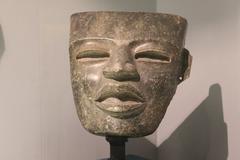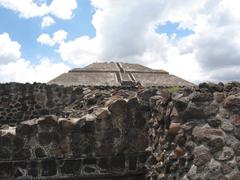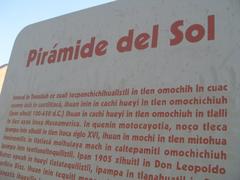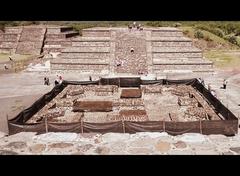Open Air Theatre of Teotihuacan: Visiting Hours, Tickets, and Comprehensive Guide to Teotihuacan Historical Sites
Date: 14/06/2025
Introduction: The Open-Air Theatre of Teotihuacan and Its Significance
Teotihuacán, known as “the place where the gods were created,” is among Mexico’s most remarkable archaeological wonders, located about 40 kilometers northeast of Mexico City. Established around the first century CE, this ancient metropolis was a cultural, religious, and economic powerhouse, renowned for its monumental pyramids, grand avenues, and advanced urban planning (World History). Today, Teotihuacán is not only a UNESCO World Heritage Site but also home to innovative cultural initiatives like the Open-Air Theatre, which brings the city’s history to life through performances, reenactments, and multimedia experiences.
Unlike traditional theatres, the Open-Air Theatre utilizes Teotihuacán’s expansive ceremonial spaces—particularly the Avenue of the Dead—as a dynamic stage for immersive events. The acclaimed “Experiencia Nocturna en Teotihuacán” exemplifies this approach, transforming the ancient ruins into a living theatre that fuses historical narrative with cutting-edge light and sound technology (Ticketopolis; Curious Sparrow Travel).
This guide provides a detailed overview for travelers seeking to explore both the archaeological marvels and vibrant cultural life at Teotihuacán. It covers the site’s history, practical visiting details (hours, tickets, accessibility), travel tips, and recommendations for making the most of both daytime exploration and evening theatre events. Whether your interest is ancient history, contemporary Mexican culture, or immersive performance, this resource will help you plan an unforgettable visit (LaidBackTrip; greekreporter.com).
Contents
- Origins and Early Development
- Urban Planning and Architectural Achievements
- Cultural and Religious Significance
- Peak and Influence
- Decline and Abandonment
- Rediscovery and Modern Significance
- Visiting Teotihuacán: Tickets, Hours & Tips
- Visiting Hours
- Ticket Information
- Getting There
- Guided Tours and Accessibility
- Nearby Attractions
- The Open-Air Theatre: Context and Modern Role
- Experiencing the Open-Air Theatre: Event Structure, Tips, and Responsible Tourism
- Visiting the Open-Air Theatre: Location, Hours, Facilities, and FAQs
- Enhancing Your Visit: Visuals, Maps, and Practical Recommendations
- Summary and Recommendations
Origins and Early Development
Teotihuacán emerged as one of the Americas’ most significant ancient cities. Settled as early as 150 BCE, its development was fueled by the fertile Basin of Mexico. Over centuries, it grew into a major urban center, famed for its monumental scale and mysterious origins (World History). The name “Teotihuacán,” meaning “the place where the gods were created,” was given by the Aztecs long after the city’s decline; the original designation is unknown (Discover Magazine).
Urban Planning and Architectural Achievements
Teotihuacán’s cityscape reflects advanced planning and engineering. Covering around 20 square kilometers, it was one of the world’s largest cities in its era (Every Steph). Its grid system, residential compounds, and astronomically-aligned monuments—such as the Pyramid of the Sun, Pyramid of the Moon, and Temple of the Feathered Serpent—demonstrate both practical and ritual sophistication. The Avenue of the Dead, a grand processional road, links these monuments and is thought to align with celestial events (Mexico Tours).
Cultural and Religious Significance
Teotihuacán was not just a political and economic center but also a cosmopolitan, multi-ethnic religious hub. Its murals and structures reveal a society deeply invested in ritual, astronomy, and cosmology (World History). Trade and cultural exchange extended to distant regions, evidenced by Teotihuacán artifacts found across Mesoamerica (Travel With The Greens).
Peak and Influence
At its zenith (300–600 CE), Teotihuacán boasted a population of up to 200,000, rivaling the world’s largest cities (Rutopia). Its influence shaped later Mesoamerican civilizations in architecture, urban planning, and religious practices (Mexico Historico). The city thrived economically, especially through obsidian trade (Travel With The Greens).
Decline and Abandonment
Teotihuacán declined in the 7th century CE due to factors like internal unrest or environmental change (Discover Magazine). By 750–800 CE, it was mostly deserted. The Aztecs later revered it as a sacred site, folding its myths and ruins into their own cosmology (Every Steph).
Rediscovery and Modern Significance
Centuries after its abandonment, Teotihuacán continued to fascinate indigenous and European observers. Recognized today as a UNESCO World Heritage Site, it draws millions of visitors annually and remains a site of active archaeological research (Mexico Tours).
Visiting Teotihuacán: Tickets, Hours & Tips
Visiting Hours
- Archaeological Site: Open daily, 9:00 AM – 5:00 PM.
- Open-Air Theatre: Evening hours for special events (typically starting at 7:00 PM).
Ticket Information
- General Admission: Around 80–90 MXN (~$4–5 USD).
- Discounts: Available for students, seniors, and residents.
- Online Purchase: Recommended for popular events to avoid lines (Ticketopolis).
Getting There
- From Mexico City: Buses depart regularly from Terminal del Norte (“Piramides” route), taking about an hour (LaidBackTrip).
- Other Options: Taxis and guided tours are widely available.
Guided Tours and Accessibility
- Guided Tours: Highly recommended for in-depth experience. Many offer English-speaking guides or audio tours.
- Accessibility: The site is vast and uneven; while some accessible routes exist, mobility can be challenging near the pyramids.
Nearby Attractions
- Local Town: San Juan Teotihuacán offers crafts, cuisine, and accommodations.
- Other Sites: Basilica of Our Lady of Guadalupe and central Mexico City attractions are within easy reach.
The Open-Air Theatre: Context and Modern Role
While not an ancient structure, the Open-Air Theatre at Teotihuacán is a modern initiative that turns the archaeological zone into a living stage. Events such as the “Experiencia Nocturna” use multimedia projections, guided walks, and live performances to immerse visitors in Teotihuacán’s mythological and historical legacy (Ticketopolis; Curious Sparrow Travel).
Experiencing the Open-Air Theatre: Event Structure, Tips, and Responsible Tourism
Event Structure
- Venue: Events are staged along the Avenue of the Dead, with the pyramids as dramatic backdrops.
- Experience: Evening shows include a guided illuminated walk and multimedia mapping on the Pyramid of the Sun.
Types of Performances
- Light and Sound Shows: Multimedia projections narrate the city’s history (Ticketopolis).
- Traditional Dance and Music: Live performances, often during equinoxes or festivals (All Events In).
Practical Tips
- Tickets: Purchase online in advance for special events (Ticketopolis).
- Clothing: Layered, comfortable attire is best; evenings can be cool.
- Footwear: Wear sturdy shoes for uneven surfaces.
- Essentials: Bring water, sun protection, and cash for vendors (Traveling With Aga).
- Respect: Stay within marked areas, avoid touching structures, and be mindful during performances (Mexico Travel Blog).
Accessibility and Facilities
- Most areas are accessible via paths, but terrain can be uneven.
- Restrooms and basic amenities are near main entrances.
- Food vendors operate outside the archaeological zone; bring your own water and snacks.
Responsible Tourism
All events are coordinated with INAH to ensure the preservation of the site (Britannica). Visitors are urged to observe regulations and support sustainable tourism.
Visiting the Open-Air Theatre: Location, Hours, Facilities, and FAQs
Location and Access
Within the Teotihuacán Archaeological Zone, the Open-Air Theatre is easily reached from main entrances (LaidBackTrip). Buses from Mexico City’s Terminal Norte run every 30 minutes.
Opening Hours and Tickets
- Site: Daily, 9:00 AM–5:00 PM (including Mondays; many Mexican museums close Mondays).
- Tickets: 80–90 MXN; special event tickets may cost more and should be purchased in advance for popular performances (Solemate Adventures).
Facilities
- Restrooms: Located at entrances and near the museum.
- Accessibility: Flat paths but some uneven ground; assistance recommended for mobility-impaired visitors.
- Shade: Minimal—bring sun protection.
FAQs
Q: What are the Open-Air Theatre visiting hours?
A: 9:00 AM–5:00 PM for general site, later for evening events.
Q: How can I buy tickets?
A: At site entrances or online for special events.
Q: Are guided tours available?
A: Yes, both from Mexico City and on-site.
Q: Is the theatre accessible for people with disabilities?
A: Most areas are accessible, but some sections require assistance.
Q: What should I bring?
A: Sun protection, water, comfortable shoes, camera, and a light jacket.
Enhancing Your Visit: Visuals, Maps, and Practical Recommendations
- Interactive Map: Plan your route and identify key landmarks.
- Best Times to Visit: November–April offers dry, mild weather; arrive early to beat crowds.
- Combine Activities: Climb the pyramids, visit the museum, and enjoy theatre events for a full experience.
- Dining: Try La Gruta restaurant or local stalls outside the archaeological zone.
Summary and Recommendations
Teotihuacán stands as a testament to ancient ingenuity and cultural richness. The Open-Air Theatre revitalizes this legacy, merging history with contemporary performance art. Visitors benefit from accessible transportation, reasonable ticket prices, and a variety of guided and digital resources for deeper understanding. For the best experience:
- Arrive early and plan for weather.
- Respect site rules, especially during performances.
- Use official resources like the Audiala app for guides and updates.
- Book tickets in advance for special events.
Whether you come for the pyramids, the performances, or the palpable sense of history, Teotihuacán’s Open-Air Theatre offers a uniquely immersive journey through Mexico’s ancient and living traditions (World History Edu; Curious Sparrow Travel; Mexico Tours; greekreporter.com).
References
- World History: Teotihuacán Overview
- Ticketopolis: Experiencia Nocturna en Teotihuacán
- LaidBackTrip: Teotihuacán Guide
- Greek Reporter: Animals, Rituals, People of Teotihuacán
- Mexico Tours: Ultimate Guide for Tourists
- Curious Sparrow Travel: Complete Guide to Visiting Teotihuacan
- Road Affair: Visiting Teotihuacán from Mexico City
- Official INAH Teotihuacán Site
- UNESCO World Heritage: Teotihuacán



